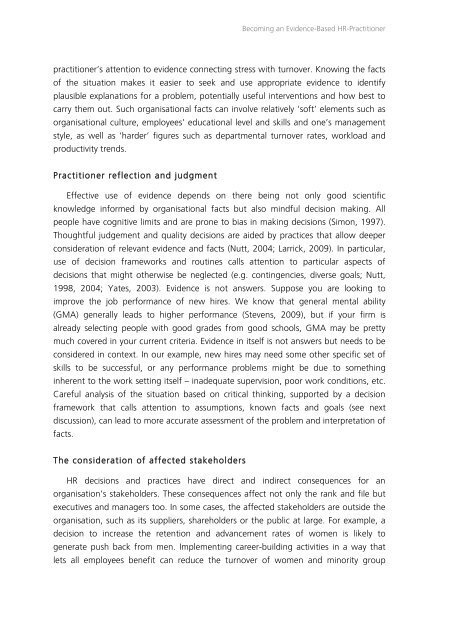In Search of Evidence
jqluvth
jqluvth
You also want an ePaper? Increase the reach of your titles
YUMPU automatically turns print PDFs into web optimized ePapers that Google loves.
Becoming an <strong>Evidence</strong>-Based HR-Practitioner<br />
practitioner’s attention to evidence connecting stress with turnover. Knowing the facts<br />
<strong>of</strong> the situation makes it easier to seek and use appropriate evidence to identify<br />
plausible explanations for a problem, potentially useful interventions and how best to<br />
carry them out. Such organisational facts can involve relatively ‘s<strong>of</strong>t’ elements such as<br />
organisational culture, employees’ educational level and skills and one’s management<br />
style, as well as ‘harder’ figures such as departmental turnover rates, workload and<br />
productivity trends.<br />
Practitioner reflection and judgment<br />
Effective use <strong>of</strong> evidence depends on there being not only good scientific<br />
knowledge informed by organisational facts but also mindful decision making. All<br />
people have cognitive limits and are prone to bias in making decisions (Simon, 1997).<br />
Thoughtful judgement and quality decisions are aided by practices that allow deeper<br />
consideration <strong>of</strong> relevant evidence and facts (Nutt, 2004; Larrick, 2009). <strong>In</strong> particular,<br />
use <strong>of</strong> decision frameworks and routines calls attention to particular aspects <strong>of</strong><br />
decisions that might otherwise be neglected (e.g. contingencies, diverse goals; Nutt,<br />
1998, 2004; Yates, 2003). <strong>Evidence</strong> is not answers. Suppose you are looking to<br />
improve the job performance <strong>of</strong> new hires. We know that general mental ability<br />
(GMA) generally leads to higher performance (Stevens, 2009), but if your firm is<br />
already selecting people with good grades from good schools, GMA may be pretty<br />
much covered in your current criteria. <strong>Evidence</strong> in itself is not answers but needs to be<br />
considered in context. <strong>In</strong> our example, new hires may need some other specific set <strong>of</strong><br />
skills to be successful, or any performance problems might be due to something<br />
inherent to the work setting itself — inadequate supervision, poor work conditions, etc.<br />
Careful analysis <strong>of</strong> the situation based on critical thinking, supported by a decision<br />
framework that calls attention to assumptions, known facts and goals (see next<br />
discussion), can lead to more accurate assessment <strong>of</strong> the problem and interpretation <strong>of</strong><br />
facts.<br />
The consideration <strong>of</strong> affected stakeholders<br />
HR decisions and practices have direct and indirect consequences for an<br />
organisation’s stakeholders. These consequences affect not only the rank and file but<br />
executives and managers too. <strong>In</strong> some cases, the affected stakeholders are outside the<br />
organisation, such as its suppliers, shareholders or the public at large. For example, a<br />
decision to increase the retention and advancement rates <strong>of</strong> women is likely to<br />
generate push back from men. Implementing career-building activities in a way that<br />
lets all employees benefit can reduce the turnover <strong>of</strong> women and minority group


